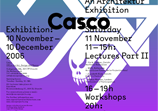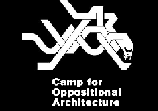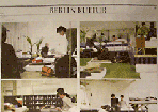The Preliminary Charter for Oppositional Architecture
Berlin-Wedding 2004/2005
This is a dynamic Charter that develops in the context of the Camp for Oppositional Architecture. This edition contains several versions and some comments, each indicated by a different color.

download charter
*The Original Provisional Charta, Berlin 6/2004
*Workshop “Social Engagement”, Berlin 6/2004
*Workshop “Cooperation”, Berlin 6/2004
*Workshop “Radical Democracy Design”, Berlin 6/2004
*An Architektur
*Allan Atlee, Judith Barber, Florian Kossak, Tatjana Schneider
*Bernard Cherix
*Ulrich Doenitz
*Lars Fisher
*Saskia Draxler
*Florian Haydn
*Birgit Schlieps
*Ifau
0.
Architecture is a process that includes research, design, construction, and the use of space that is deeply involved in social and political issues*. Thus we declare:
*social, cultural and political issues
An organization to promote an Oppositional Architecture will have to unite all workers, activists, and users involved in making and transforming our environment - that is not just architects, but construction workers, tenants, user groups and other social movements that are challenging the capitalist hegemony. Until such an organization exists to further the collective struggle for an Oppositional Architecture:
1.
We shall do no harm.
Prof. Marcuse introduced this first issue in his lecture at the camp: Ethics. I would argue that without Ethics architecture couldn’t be achieved.
Indeed paragraph 1. was controversial in Berlin already. It was brought to the fore by Peter Marcuse but questioned by Patricio del Real: the paragraph "We shall do no harm" is taken from the oath of the Hippocrates, which is sworn by doctors. That is also where it makes sense, because treating "individual entities" doctors can avoid doing harm to their clients without doing harm to anyone else. The sanity of one person does not affect the sanity of another. With architecture and urban space, however, it is different. Architects find themselves in a struggle involving the conflicting interests of different stakeholders. Doing a favor to one will harm another. Architecture is cutting space into pieces, defining barriers to access and inclusion. We distribute space among various interest groups. We do not treat an individual entity but always have to find a balance between the different interests. Doing harm to some may become necessary to achieve goals for the weak. A suggestion: We shall treat socio-spatial structures that we find with respect.
Delete: We shall do no harm.
We do not support or accept architectures of war, racism, sexism, capitalism or civilian occupation.
2.
We fight all manifestations of socio-spatial inequality*, exploitation and deprivation.
*Delete “inequality”, or it should be more explained
I am committed to fighting all manifestations of socio-spatial inequality, exploitation and deprivation. I will produce critical works and design ideas that promote a radical social and political rethinking of how we make and experience buildings and cities.
3.
We shall pursue a critique of capitalist and authoritarian forms of production and use of the built environment.
We stand against* all capitalist** and authoritarian*** forms of production and use of the built environment.
*better: oppose, **should be more specified, ***should be more specified
Maybe another remark on the anti-capitalistic issue: it might be worth reconsidering a strong criticism to capitalism as this questions the fundamentals of most western societies. It seems “slippery” to argue against Lutheran and Calvinist philosophy. I do agree that under the name of capitalism irreparable damages have been done to humankind. But writing a capitalism critical paragraph in the Charter would require bringing the issue under another perspective (such as the limit of its validity) while considering other cultures that are unable to assimilate it and open the gate to an alternative. So, I suppose the capitalist issue needs to be replaced in a more global context instead of simply being oppositional.
I oppose capitalist and authoritarian production and use of the built environment.
4.
We intervene in the production of space through knowledge and its mediation, socio-political engagement and the processes of planning and building. Architectural research should be involved from the outset in the definition of the spatial conditions which contribute to learning, healthcare, social services, communication and knowledge.
I will engage in the production of emancipated space through the means of research, education, socio-political engagement, planning, design, and construction.
We intervene in the production of space through* research, information, socio-political engagement, planning and building.
*research, information, development of methods for acquiring knowledge, documentation, performance, fiction, socio-political engagement, planning and building.
paragraph 4. is quite weak, because it describes actions nearly everybody is involved in.
5.
The definition of needs and programs has to be generated through a process of radical democracy, taking into account collective memory and local context.
We ask for the definition of needs and programs through a process of radical democracy.
The main approach of Oppositional Architecture that relies on the idea of a radical democracy should be to accept conflict as the driving force of democratic communication. The designer should not rely on a predefined notion of the users needs nor should there be a need to follow the common neoliberal stories. He should get involved in a collective process articulating individual and common needs and desires to transgress the given situation, to provoke alternative needs, offer possibilities or appropriate produced desires and connect existing desires to other goals. Do not design a solution for anybody and for everything! Open up conflicts, collect expressions of desire, serve the process!
We challenge the definition of needs and programs through a process of radical democracy, which also challenges topographical contexts as well as contexts of cultural production.
With whom can you cooperate to search for the client, to find the needs of a client? Practical point: to build up public pressure and public interest, to be used in the negotiation process with a developer, we have to organize publicity. We have to think of new forms of powerful negotiation. We have to convince them. Build up values in order to stay in the process. Keep your values. Don’t compromise too soon in a negotiation strategy. Find a surplus value with which to bargain. Always try to stay one or two steps ahead. But is it always a one on one discussion? Or do we also need to understand the values of the developer?
6.
We need passionate and fundamental participation of the manifold users of space
We ask for the passionate and fundamental participation of the manifold users and producers of space (participation and cooperation).
But who are the users? Engage yourself in a practice in which the user arises in the dialogue. Create users, let them reinvent themselves in the social context. Invent yourself. Engage in real time-processes with open results. It’s not about representation! Realize sensitization for context, relations, situations. Creating a sense of community, let people define what their common property is. What they want to share and what they do not. Produce social situations!
7.
We appreciate conflicts and aim at endless negotiations.
We support continuous negotiations of space.
comment on 7. From our point of view the word “endless” should be erased. Negotiations become meaningless in a way.
8.
We offer advice and services to individuals and social groups engaged in struggles to transform their environment.
We support individuals and social groups engaged in struggles to transform their environment.
I aim to offer advice and assistance to individuals and social groups engaged in struggles to transform their environment.
I am committed to the dissemination of my ideas to as wide an audience as possible, exploring a broad range of communication techniques.
How can we work for those outside the market? How to resist to market-realism? What about illegal practices? What could be a possible subversion? How can we use/misuse commercial forces? How to deal with consumer attitudes? Should we try to change the system from within or look for an alternative? What could be a vision beyond the existing? How to create collective spaces? How to cooperate to change the situation? How to form group-processes in times of individualism?
*other points to be developed on the themes:
labor process, production*
radical ecology, materials**
9.
*We do not accept depriving working conditions of any persons included in the design- and construction-processes.
10.
**The second issue is sustainability. Here I think that the Charter needs to address the current issues that every professional is dealing with at the present time. In our industrialized countries almost all political foundations and most governmental research funds are dealing with sustainability. As I do not think that a timeless Charter would be of any use I firmly believe that we need to integrate contemporary questions in it.
11.
As the current condition proposes only one way of making society, we want to push the border of collective imagination and use the language of architecture to propose and communicate different ways of shaping society.
We intend to push the border of collective imagination and propose alternative ways of shaping society by architecture.
12.
I subscribe to the political principles of collective self-management and ownership of ideas*.
* for an open-source and anti-copyright principle of information against the private property of ideas.
X.
The following Dogma of Oppositional Architecture adds a codex to the Charter of Oppositional Architecture to evaluate ways of production, to qualify the deriving results, and to lend them a seal of approval. For this reason it is helpful to acknowledge the critical attitude of Dogme 95 (http://www.dogme95.dk/menu/menuset.htm) and its hassle with the representation of reality. This does not mean to take over the set of rules thoughtlessly. It is rather considered as a challenge to an open and critical debate not only about definitions, but also about attitudes to the impact of political decisions upon the built environment.
1. Architecture must be done on location. Interiors and typologies must not be brought in. / 2. The program must never be produced apart from the building or vice versa. (Atmosphere must not be generated artificially. It occurs where the site is.) / 3. The building must be custom-made. Any movement or immobility attainable in the process is permitted. (Architecture must not take place where your office is; architecture must take place where the user is.) / 4. Architecture must be in true material only. Special lighting is not acceptable. (If there is too little light for exposure provide some more windows.) / 5. Fake facades are forbidden. / 6. Architecture must not contain superficial action. (Murders, weapons, etc. must not occur.) / 7. Temporal and geographical alienation are forbidden. (That is to say that architecture takes place here and now.) / 8. Genre architecture is not acceptable. / 9. The architectural format must be Dogma OA. / 10. The architect must not be credited.
Furthermore I swear as an architect to refrain from personal taste! I am no longer an artist. I swear to refrain from creating a "work", as I regard the instant as more important than the whole. My supreme goal is to force the truth out of my characters and settings. I swear to do so by all the means available and at the cost of any good taste and any aesthetic considerations. Thus, I make my vow of chastity.
 Camp 2009
Camp 2009 Camp 2006
Camp 2006 Camp 2004
Camp 2004 Press
Press